Anglo-Saxon dress
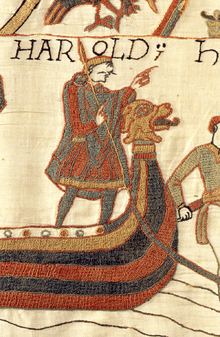
Anglo-Saxon dress refers to the variety of early medieval European dress, or clothing, worn by the Anglo-Saxons from the time of their migration to Great Britain in the 5th century until the beginning of the Norman Conquest. The line of Saxon kings began with Egbert in 827 and ended when Harold II was defeated by William the Conqueror at the Battle of Hastings cementing the Normans as the rulers of England.[1] The new Norman rulers had brought fashions from the continent that had a major effect in England. Anglo-Saxon dress had several different periods of transformation and the study of these periods includes examination of individual pieces of clothing, the textiles, and how the clothing was made.
Materials
The type of materials used by the Anglo-Saxon women to clothe their communities were mostly materials they had from their farm animals and their farm land. Wool, flax and hemp were most common. Hemp and flax were spun for yarn. Leather was made from slaughtered farm animals.[2] Woman were responsible for tending to the sheep and their wool was spun for yarn. Wool was mostly used in natural colors.[3] About 70% of a woman's year was spent making textiles.[4] Wool was a coarse material which was used for most garments. Lower-class people, such as slaves (theowas) and poorer peasants (geburas), could only use wool for their garments, even for those worn against the skin. Linen, harvested from the flax plant, was a finer material which was used for garments that were worn close to the skin by higher class peasants (kotsetlas and geneatas) and those above them in the social hierarchy. Silk was an extremely expensive material and was used only by the very rich, and then only for trim and decoration.
Men's clothing
The primary garment consisted of a knee-length woollen tunic. For the poorer theow, this would be the only clothing worn, although some may have been given woolen trousers and shoes to wear. A gebur would be able to afford woollen trousers and leather shoes, and would also carry a knife (called a seax), which signified their freedom in the eyes of medieval Anglo-Saxon society. A linen undertunic (worn under the outer woollen tunic) and linen braies (reaching to the ankle or knee[5]) would be worn by richer peasants and nobility, along with woollen hose which would be held up by garters or decorative embroidery around the top.[6] During the 11th century, the length of the braies decreased and the length of the hose increased, eventually resulting in a garment which somewhat resembled modern shorts.[7] Geneatas and thegns would often have cross-gartering on their hose, along with leather turnshoes. Over the tunic, a cloak would be worn, which was held together by a brooch or, later on, a ring (functional buttons not being invented until the 13th century). There are several illustrations of warriorlike persons wearing headgear similar to Phrygian caps or helmets found in 10th and 11th century Anglo-Saxon manuscripts. It is possible, though, that these images do not depict any actual fashion of the period, but rather copies of much older Byzantine or Roman originals, little understood by the copyist.[8][9] Hoods would also be worn.[10]
Common attire
Men of the northern tribes of 5th and 6th century England dressed alike regardless of social rank. The fashions during this time consisted of the cloak, tunic, trousers, leggings, and accessories. The short, fur-lined cloak was designed so that the skin of the animal faced outward and the fur brushed against the undergarments. However, woollen cloaks have also been found. The garment opened either at the front or at the right shoulder. A single brooch, usually circular in shape, fastened the square or rectangular cloak. Other means of fastening the cloth together included tying, lacing, or using a clasp, often made of natural materials such as thorn, bones, wood, or horns. The less prosperous wore woollen cloaks.[11]
The tunic ended between the hip and the knee and had either long or short sleeves. Clasps were not needed to hold the tunic together because when pulled over the head it would sit snugly around the neck without the use of lacing or ties, indicating that the garment was one continuous piece. A belt or girdle was usually worn with the tunic and might have had a buckle, and, as Owen-Crocker states, "pouched over the belt".[12]
Trousers, traditionally worn under a short tunic or with a small cloak, were ankle length. If loose, the excess material was bunched around the waist and, as Gale Owen-Crocker describes, "hung in folds around the legs".[13] Garters or leggings accompanied narrow trousers. Pieces of fabric attached to the trousers formed belt loops so that the garment could be held in place at the waist by a belt.[14]
Leggings, usually worn in pairs, acted as additional protection for the legs. The first legging, referred to as the legging proper or stocking, consisted of woven fabric or leather. The second was simply a piece of fabric used to tie on the leggings or, if worn around the shin or foot, provided warmth and protection. The lower caste wore leggings made of ripped or cut cloth from old clothes, blankets, or bags whereas the upper caste had custom made leggings.[15] The very rich people sometimes wore jewels.
Belts worn at the hips were more of a necessity rather than a luxury. Buckles were common and most faced the front; however others have been found to face both sides or even, in some cases, were placed at the back of the body. Owen-Crocker mentions that "belt ornaments and tags" dangled from the belts of the Anglo-Saxons in addition to everyday equipment.[16] Beads occasionally acted as alternatives, although not often. Leather belts, often decorated, were the most common, often as much as 2 inches wide.[17] Intricate belts, worn to be seen, were placed in view while an additional belt or girdle held the trousers in place under the tunic.[18]
The Anglo-Saxons usually covered their bare feet, except when working. Shoes were made of leather and secured with straps.[19] Hats and hoods were commonly worn, as were gloves and mittens.[20]
Seventh to tenth centuries

General attire
Clothing of the seventh through the 9th centuries was similar to that of previous centuries and again all classes generally wore the same clothing, although distinctions among the social hierarchy began to become more noticeable through ornamented garments. These common pieces consisted of tunics, cloaks, jackets, trousers, and shoes. As in the 5th and 6th centuries, a linen shirt acted as an undergarment. Men generally wore a knee-length linen or woollen tunic, depending on the season, over their shirts. The sleeves of the tunic were long and close fitting and excess material was pushed up the arm from the elbow to the wrist so that "rolls" were formed in the material.[21] The neck of the tunic opened as did both sides and a belt or girdle was usually worn around the waist. According to rank, embellishments adorned the collar of the tunic, waist, or border and for peasants, or the working classes, a plain tunic with sleeves was generally worn. Examples of these decorations included, as Planché states, "gold and silver chains and crosses, bracelets of gold, silver or ivory, golden and jeweled belts, strings of amber and other beads, rings, brooches, [and] buckles".[22] The nobility tended to wear longer tunics than the lower social classes.[23]
A cloak, worn over the tunic, fastened on either the breast or a shoulder with the assistance of a brooch. Once in place, the brooch was left attached to the garment so that the cloak was slipped over the head.[24] The cloak, knee-length and rectangular in shape, was fastened so that it appeared to be pleated or folded. Hoods and collars began to appear in the 9th century, and around the same time, the cloak began to be curbed by the same belt that was worn over the tunic.[25] Such belts were narrower than earlier in the Saxon period, with fewer tools hanging from them.[17] The wrap-over coat also made an appearance during this era. This knee-length coat wrapped over the front of the body. Its sleeves were, as Owen-Crocker says, "deep, [with] decorated cuffs which [were] mostly straight".[26] For the lower classes, this coat tended to be plainer than that of the nobility.[26]
The jacket appeared during this time as well. For those who could afford it, the jacket was made of fur while less costly ones were made of linen. This jacket was waist-length and tended to have a broad collar.[27]
The trousers in this era were shortened to mid-thigh and stockings, made of leather, met them there. Atop the stockings, rounds of cloth, linen, or leather (Puttee) were worn which started at the ankle and ended just below the knee, as Planché explains, in "close rolls… or crisscrossing each other sandal-wise".[28] Planché states that socks began to be worn over the stocking and were "banded at the top".[29] Shoes of this era, painted black, had an opening down the instep and were secured with straps. Anglo-Saxons appreciated shoes and thus all classes wore them. Common colours for this era consisted of red, blue, and green.[30]
King
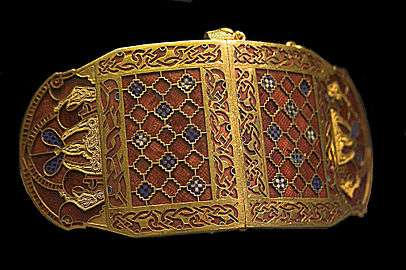
Until the 9th century, the king or reigning authority wore ringed byrne which, as Planché explains, was "formed of rings sewn flat upon a leather tunic".[31] This person also carried a projecting shield and "long, broad, straight iron sword" as Planché states.[31] A square crown was worn as was a longer cloak.[25][32] Beginning in the 9th century, the metal of the king was inscribed and later in the century silk began to be worn by both the king and the nobility.[33]
Clergy
Planché asserts that the clergy of the 9th and 10th centuries dressed similarly to the laity, except when saying mass. Beginning in the later 8th century, the clergy were forbidden to wear bright colours or expensive or valuable fabrics.[34] Owen-Crocker mentions that their twill cloaks were generally shorter than those of the laity, reaching just below the waist, and Planché adds, that they wore linen stocking.[28][35]
Eleventh century
General attire
Planché explains that in the 11th century, shortened tunics became popular as did shorter hair styles and beard lengths. Piercings also became fashionable for men as did golden bracelets.[36] During this era men continued to wear tunics, cloaks, and trousers which did not vary much from their previous counterparts. Coifs became popular head-coverings and appeared to be "flat round cap[s]".[37] Long stockings, with feet attached, were in style, and leg bandages and shoes continued to be worn. Short boots, those only extending to the ankle, were introduced in the latter part of the century.[37]
King
Until the 9th century, the king or reigning authority wore ringed byrne which, as Planché explains, was "formed of rings sewn flat upon a leather tunic". This person also carried a projecting shield and "long, broad, straight iron sword" as Planché states. A square crown was worn as was a longer cloak. Beginning in the 9th century, the metal of the king was inscribed and later in the century silk began to be worn by both the king and the nobility. Kings of the 9th century were also known to wear rings made from various materials and may have engravings on them. Such a ring was worn by King Athulwulf (839 - 856).[1][38]
Military attire
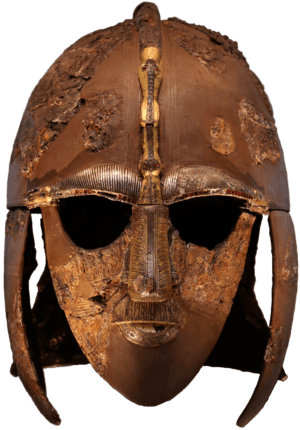
Well-armed Anglo-Saxon soldiers wore wrap-over coats decorated like chain mail with sleeves that narrowed at the wrists.[32][26] Owen-Crocker explains that the belts of commanders were elaborate, wide, and fastened by "a narrow strap which was riveted to the broad belt and passed through a buckle which was much narrower than the belt itself" leaving the end of the belt to hang down; attached to the belt were pouches which allowed soldiers to carry their weapons.[39] In the 9th and 10th centuries, military attire did not differ much from that of civil attire. The only changes were in the form of short linen tunics with metal collars and the addition of a sword, spear, shield, and helmet.[40] Weapons and clothes fittings worn on the battlefield were highly decorated with jewellery techniques, as seen in the discoveries at Sutton Hoo and in the Staffordshire Hoard; the concept of parade wear did not exist for the Anglo-Saxons.
Clergy
The clergy of the 11th century had shaved heads and wore hats which, according to Planché, were "slightly sinking in the centre, with the pendent ornaments of the mitre attached to the side of it".[41] Other garments included the chasuble, the outermost liturgical vestment, which retained its shape, and the dalmatics, a tunic like vestment with large, bell shaped sleeves, which tended to be arched on the sides. The pastoral staff was generally found to be plain in color and ornamentation.[41]
Women's clothing
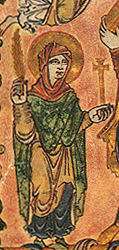
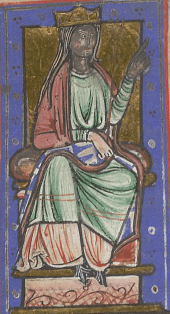
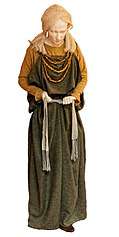
Fifth to Sixth Centuries
Evidence from burials shows that during the Early Migration Period until the late Sixth or early Seventh Century, women wore something similar to a Greek peplos.[42] They were fastened by brooches at the shoulders,[43] though they have sometimes been found as low as the breasts.[43] The gown could be belted or girdled, and easily adjusted to changes in the woman's physiology (weight change, especially due to pregnancy).[44] An undergown was worn underneath, made of wool for poorer people and linen for richer women. It is unknown what the Anglo-Saxons called the peplos style of overdress, or how long it was; in Grave 74 at Wakerley in Northamptonshire, the underdress appears to have been of patterned twill, suggesting that the peplos was short to allow the underdress to be seen.[45] Archeological finds suggest the underdress had an aperture at the neck. Finds on belt buckles also show that there were three layers of material, opening up the possibility of women having worn underwear beneath the undergown, though that is speculative.[46]Relics from grave sites suggest women wore belts and girdles. Belts were used to hold the clothing together at their waist and could be adjusted during pregnancy. Sometimes two belts were worn to help during pregnancy. One of the functions of the brooches at the shoulders would allow for ease of breast feeding. Along with the brooches at their shoulders women sometimes had brooches at their hips as well. It seems these brooches were used to carry tools.[47]
Seventh to Tenth Centuries
Women's clothing styles changed and evolved throughout the seventh to tenth centuries. This was determined by the lack of brooches found in the burial remains. They would have started wearing a roman style of dress. Women started wearing different gowns that didn't need to be attached by brooches but cords and stitching. They were also wearing brightly colored clothing. They would have kept their hair under a head-covering. Women were found having some jewelry with them during burial. Bracelets that may have been used to hold the bottom of their sleeves, and some even wore necklaces with animal teeth on them.[48]
The main garment for a woman was a woolen gown of calf or ankle length. Normally, it would be brown or black. Occasionally it would be a deep red but only when two gowns were worn, with the inner gown having longer and tighter sleeves, and the outer gown having shorter and looser sleeves.[49] Under this might be worn a linen or woolen underdress. A mantle might be worn over the outer dress, along with a cloak. Usually this cloak was of bright colors, red, blue, or yellow, but sometimes it was of a dingier red or blue and could also be an off-white or black. The women's footwear was often scanty. Unlike the men, they often had bare feet. When they wore shoes, they were usually either a stretchy woolen sock or a gray shoe that was worn with linen or wool socks. Like men, free women would also carry a seax as a sign of their freedom.
After the introduction of Christianity, all women (except for very young girls and occasionally slaves) would wear some kind of head-covering,[50] usually a draped couvrechef called a headrail, the ancestor of the later wimple. Often this headcovering would be black or pale brown. It was almost always made of wool. Brooches were worn, though not only for decorative purposes but functional ones as well. They could fasten the garment or an outer garment to an inner one.[51]
Children
Children wore smaller versions of adult clothing.[52] Children are always found with one knife rather than several, and smaller than the adults'.[52] Children's clothes were stitched together. No brooches or buckles were found in their burials. Children had simple clothing.[53]
See also
References
- 1 2 Johnson, Ben. "Kings and Queens of England & Britain - Historic UK". Historic UK. Retrieved 2018-05-04.
- ↑ Walton-Rogers, Penelope (2007). Cloth and Clothing in Early Anglo-saxon England AD 450-700. Council for British Archaeology.
- ↑ Walton Rogers, Penelope (2007). Cloth and Clothing in Early Anglo-Saxon England AD 450-700. Council for British Archaeology.
- ↑ Walton Rogers, Penelope (2007). Cloth and clothing in Early Anglo-Saxon England AD 450-700. the council for British Archaeology. p. 9.
- ↑ Quennell & Quennell 1927, p. 22.
- ↑ Brooke 2000, p. 20.
- ↑ Brooke 2000, p. 36.
- ↑ Arms & Armour 7 - Helmets, Regia Anglorum
- ↑ Ohlgren 1991, p. 21.
- ↑ "Members Handbook: Saxon" (PDF). Regia Anglorum. January 2007. p. 23. Archived from the original (PDF) on 10 September 2015.
- ↑ Owen-Crocker 2004, pp. 106–110.
- ↑ Owen-Crocker 2004, pp. 112-114.
- ↑ Owen-Crocker 2004, p. 115.
- ↑ Owen-Crocker 2004, pp. 115-17.
- ↑ Owen-Crocker 2004, p. 118.
- ↑ Owen-Crocker 2004, p. 119.
- 1 2 Costume, Thegns of Mercia
- ↑ Owen-Crocker 2004, pp. 119-21.
- ↑ Owen-Crocker 2004, p. 123.
- ↑ Owen-Crocker 2004, p. 126.
- ↑ Planché 1879, p. 32.
- ↑ Planché 1879, p. 36.
- ↑ Planché 1879, pp. 28, 32–35.
- ↑ Planché 1879, p. 33.
- 1 2 Owen-Crocker 2004, p. 179.
- 1 2 3 Owen-Crocker 2004, p. 180.
- ↑ Owen-Crocker 2004, p. 181.
- 1 2 Planché 1879, p. 34.
- ↑ Planché 1879, p. 35.
- ↑ Planché 1879, pp. 34–38.
- 1 2 Planché 1879, p. 28.
- 1 2 Planché 1879, p. 27.
- ↑ Planché 1879, pp. 35, 36.
- ↑ Planché 1879, pp. 51–52.
- ↑ Owen-Crocker 2004, p. 178.
- ↑ Planché 1879, p. 67.
- 1 2 Planché 1879, pp. 71–72.
- ↑ "Anglo-Saxon fashion history. England c. 460 to 1066. | Costume History". Costume History. 2016-11-22. Retrieved 2018-05-04.
- ↑ Owen-Crocker 2004, p. 120.
- ↑ Planché 1879, p. 41.
- 1 2 Planché 1879, p. 83.
- ↑ Owen-Crocker 2004, pp. 36, 53.
- 1 2 Owen-Crocker 2004, p. 42.
- ↑ Owen-Crocker 2004, p. 49.
- ↑ Owen-Crocker 2004, p. 38.
- ↑ Owen-Crocker 2004, p. 61.
- ↑ Crocker, Owen. Dress in Anglo-Saxon England. p. 62.
- ↑ English Costume.
- ↑ Quennell & Quennell 1927, p. 25.
- ↑ Brooke 2000, p. 14.
- ↑ Owen-Crocker 2004, p. 36.
- 1 2 Owen-Crocker 2004, p. 102.
- ↑ Crocker, Owen. Dress in Anglo-Saxon England. p. 64.
Bibliography
- Brooke, Iris (2000). English Costume from the Early Middle Ages through the Sixteenth Century. Mineola, NY: Dover Publications, Inc. ISBN 0-486-41238-5.
- Ohlgren, Thomas H. (1991). Anglo-Saxon Art: Texts and Contexts. Binghamton, New York: Modern Language Association of America, Old English Division; Center for Medieval and Early Renaissance Studies, SUNY-Binghamton. OCLC 24485915.
- Owen-Crocker, Gale R. (2004) [1986]. Dress in Anglo-Saxon England (rev. ed.). Woodbridge: Boydell Press. ISBN 9781843830818.
- Planché, James Robinson (1879). A Cyclopaedia of Costume Or Dictionary of Dress, Including Notices of Contemporaneous Fashions on the Continent: A general chronological history of the costumes of the principal countries of Europe, from the commencement of the Christian era to the accession of George the Third. 2. London: Chatto and Windus. OCLC 760370.
- Quennell, Marjorie; Quennell, C. H. B. (1927). Everyday Life in Anglo-Saxon, Viking, and Norman Times. New York: The Knickerbocker Press.
Further reading
- Owen-Crocker, Gale R. (1999). "Women's clothing in the 10th and 11th centuries". In Karkov, Catherine. The Archaeology of Anglo-Saxon England: Basic Readings. Garland.